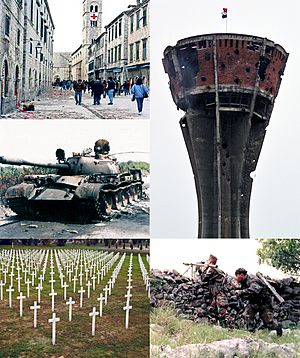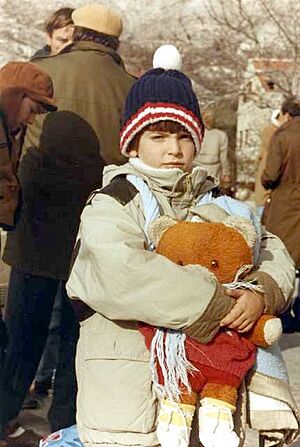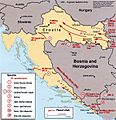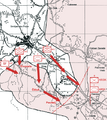Croatian War of Independence facts for kids
Quick facts for kids Croatian War of Independence |
|||||||||
|---|---|---|---|---|---|---|---|---|---|
| Part of the Yugoslav Wars | |||||||||
 Clockwise from top left: the central street of Dubrovnik, the Stradun, in ruins during the Siege of Dubrovnik; the damaged Vukovar water tower, a symbol of the early conflict, flying the Flag of Croatia; soldiers of the Croatian Army preparing to destroy a Serbian tank; the Vukovar Memorial Cemetery; a Serbian T-55 tank destroyed on the road to Drniš |
|||||||||
|
|||||||||
| Belligerents | |||||||||
| 1991–94: |
1991–92: |
||||||||
| 1994–95: |
1992–95: |
||||||||
| Commanders and leaders | |||||||||
| Strength | |||||||||
| Casualties and losses | |||||||||
8,685 soldiers and 6,322 civilians killed or missing 300,000 displaced |
4,484 soldiers and 2,650 civilians killed or missing 3,486 soldiers, 2,677 civilians and 864 unidentified killed or missing 300,000 displaced |
||||||||
The Croatian War of Independence was a conflict fought in Croatia from 1991 to 1995. It was part of the larger Yugoslav Wars. This war happened when Croatia wanted to become an independent country, separate from Yugoslavia.
The main groups fighting were the Croatian forces, who were loyal to the new government of Croatia, and the Serb-controlled Yugoslav People's Army (JNA) along with local Serb forces in Croatia.
In Croatia, people often call this war the "Homeland War" (Croatian: Domovinski rat). Some also refer to it as the "Greater-Serbian Aggression." In Serbian sources, it's usually called the "War in Croatia" or sometimes the "War in Krajina."
Contents
Why the War Started
Breakup of Yugoslavia
Yugoslavia was a country made up of several republics, including Croatia and Serbia. In the late 1980s and early 1990s, different parts of Yugoslavia wanted to become independent. This led to a lot of tension and disagreements.
Croatia declared its independence from Yugoslavia in 1991. However, many Serbs lived in Croatia, and they did not want to separate from Yugoslavia. This disagreement quickly turned into a conflict.
Rising Tensions
Before the war, there were growing political tensions between Croats and Serbs. Nationalist feelings became stronger on both sides. This made it harder for people to find peaceful solutions.
The Yugoslav People's Army (JNA), which was mostly controlled by Serbia, supported the Serb forces in Croatia. This made the conflict much bigger and more serious.
Key Events of the War
Early Fighting (1991-1992)
The war began with smaller clashes in 1991. Soon, the fighting became widespread. The JNA and Serb forces attacked many Croatian cities.
One of the most famous battles was the Siege of Vukovar. The city of Vukovar was almost completely destroyed during this long and difficult siege. Many people were killed or forced to leave their homes.
Another important event was the Battle of the Barracks. Croatian forces managed to capture many JNA barracks. This helped them get much-needed weapons and equipment.
United Nations Involvement
In 1992, the United Nations (UN) stepped in to try and stop the fighting. They sent peacekeeping forces to Croatia. A ceasefire agreement was signed, and the JNA officially withdrew from Croatia.
However, fighting continued in some areas. Serb forces in Croatia formed their own state called the Republic of Serbian Krajina. This area was not recognized by other countries.
Later Stages (1993-1995)
From 1993 to 1995, the war continued with smaller battles. Croatian forces slowly grew stronger and better organized. They launched several military operations to regain control of their territory.
In 1994, Croatia also started working with Bosnia and Herzegovina. This alliance helped them fight against Serb forces in the region.
Operation Storm (1995)
The war largely ended with a major Croatian military operation called Operation Storm in August 1995. This operation quickly took back most of the territory held by the Republic of Serbian Krajina.
Operation Storm led to a large number of Serbs leaving Croatia. This event is still a sensitive topic for many people.
Aftermath of the War
Peace and Recovery
After Operation Storm, the remaining Serb-held areas in eastern Croatia were peacefully integrated back into Croatia through a UN mission called UNTAES. This happened by 1998.
The war caused a lot of damage to Croatia's cities and economy. Many people were killed or went missing. Hundreds of thousands of people were forced to leave their homes.
Impact on People
The war had a lasting impact on the people of Croatia and the surrounding region. Many families were affected, and communities were torn apart.
Today, Croatia is an independent country and a member of the European Union. The war is an important part of its modern history.
Images for kids
-
Map of the strategic offensive plan of the Yugoslav People's Army (JNA) in 1991 as interpreted by the US Central Intelligence Agency
-
Territories controlled by Serb forces during the Yugoslav Wars. It is widely believed that Milošević tried to create Greater Serbia, which would unite all Serbs across a collapsing Yugoslavia.
See also
 In Spanish: Guerra de Croacia para niños
In Spanish: Guerra de Croacia para niños


















